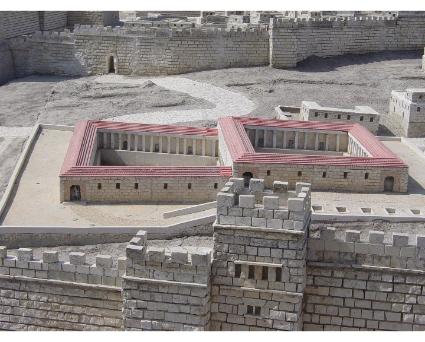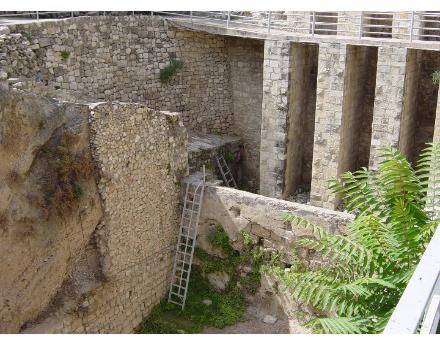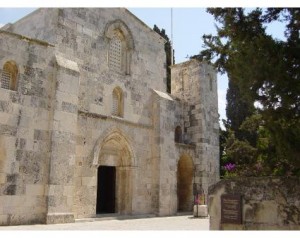In John 5:1-15, we read the story of Jesus in Jerusalem for some unnamed feast. While there, he encountered a disabled man at the Pool of Bethesda. After questioning the man concerning his willingness to be healed Jesus commanded him: “Get up! Pick up your mat and walk” (v. 8). The man did this, much to the amazement of everyone, especially the Jewish leaders.
Pool of Bethesda from the Ancient Jerusalem Model City
This account of the healing at the Pool of Bethesda represents Jesus’ first truly public miracle. His previous two miracles were rather private ones. Not only was this miracle of a public nature but it was done on the Sabbath day, and that brought about the first real opposition to Jesus’ ministry from the Jewish leaders.
Of course the immediate problem was that Jesus commanded the healed man to carry his mat. We see in the Bible that carrying a burden was forbidden on the Sabbath day (Exo. 20:8-10; Neh. 13:15; Jer 17:21). In fact, the Jewish leaders had listed 39 prohibited tasks on the Sabbath and bearing a burden was one of them. In their zeal to keep the letter of the law these leaders missed the miracle entirely. They also missed the sign that their own Messiah had come. Had they only considered Isaiah 35:6 they would have remembered this about his ministry: “Then will the lame leap like a deer.”
On this and several other occasions (Mt. 12:9-14; Lk. 14:1-6) Jesus seemed to make a special point of healing on the Sabbath. He felt that the Sabbath was made for man and not man for the Sabbath (Mk. 2:28). Jesus felt it was proper to do good on the Sabbath rather than evil (Lk. 6:9). Since God was still working he thought it necessary that he be working as well (Jn. 5:17). He once reminded the leaders that they would quickly lead their donkeys to water on the Sabbath (Lk. 13:15) or rescue sheep that had fallen into a pit (Mt. 12:11), but they would not allow a needy person to be helped. In the end Jesus made this bold claim: “For the Son of Man is Lord of the Sabbath” (Mt. 12:8).
PLACE OF THE MIRACLE
It has been confirmed by much modern scholarship that this miracle of Jesus happened at the Pool of Bethesda as is named in scripture. We see that this pool was near the Sheep Gate, a site which is mentioned in Nehemiah 3:1-2 and 12:39. Today the closest city gate is the Lions’ or St. Stephen’s Gate in the eastern wall.
The Pool of Bethesda today
The Pool of Bethesda was excavated in 1915 and again in 1958. The pool has been identified with the Sheep Pool which was located near the Sheep Market in ancient times. The pool is very deep, some 15 meters (45 feet) and measures 50 x 150 meters in size (160 x 480 feet). It is divided into two sections, the northern pool and southern pool. Straddling the pools are the ruins of a fifth century Byzantine basilica and later ruins of a Crusader chapel. Many sources claim that the excavated pool has five porches as is mentioned in scripture. This is not clearly evident by looking at the remains of the pool today. Immediately to the east of the ruins are later bathing pools which are thought to be connected to the Roman god of healing, Aesculapius.
At the southeastern end of the excavation is located the beautiful 12th century Crusader church of St. Anne. In Catholic tradition Anne and Joachim were the parents of Mary, Jesus’ mother. This church is an excellent example of Romanesque style and has survived intact through wars and earthquakes. At one point the church was taken over by the Muslims and became a theological school. The Islamic inscription bearing witness to this is still seen over the entryway. Tourists visiting this site are usually amazed at the great acoustics this building affords. It is often a place where visiting choirs and other tour groups rest their feet while they exercise their vocal chords a bit by singing hymns and choruses.
THE MAN IN THE MIRACLE
Saint Anne’s Church at the site
Much has been said by way of comment and speculation concerning the poor man in this miracle of Jesus. Many note how Jesus asked the man that all important question, “Do you want to get well?” (v. 6b). All of us probably know people in our life experiences who really don’t want to be well for one reason or another. It is almost impossible for one in such a frame of mind to actually get well. Even miraculous cures may not last in such cases. Also for some Jerusalem beggars with good locations it appears that they may make a pretty good living doing nothing.
Various commentators have noted that the story of this man is a sort of parable or allegory picturing Israel and her lame condition. The man had been an invalid for 38 years. In their thinking this corresponds to the 38 years Israel was in the wilderness (Deut. 2:14) and unable to enter the Promised Land. In fact, at that very hour Israel was still an invalid, unable to enter into the good things God had in store. Some have suggested that the five porches represent the law while the waters represent baptism and salvation
in Yeshua.
It is interesting that the man does not appear to show much faith. This miracle seems to almost be one of grace alone. Clearly the man continues to think in near magical terms of the angel stirring the waters. Incidentally, the verses 3b and 4 which speak of the angel stirring the water are missing in all early manuscripts of the Bible before AD 400. Thus they are omitted in many newer translations like the New International and New Revised Standard Versions. It may well have been that this account was an early oral tradition carried on by believers although not included in the earliest copies of the Bible.
Others have pointed out that this man never seemed to show much gratitude for being healed. He did go immediately to the Temple where Jesus later found him and that was a good sign. This trip to the Temple was surely one he had not been able to make on his own for 38 years. Still it is of note that he didn’t face the immediate persecution that the blind man of John chapter 9 faced, since the latter was excommunicated for his belief in Jesus.
In the man’s Temple exchange with Jesus we see that his condition was apparently the result of some specific sin in his life. Obviously all sicknesses and even death are caused indirectly by sin and the fact that we have inherited these things from Adam. It is clear in scripture that certain sins cause specific problems in our lives. For instance, the sin of envy rots the bones (Pro. 14:30). The sin of pride brings destruction (Pro. 16:18). The sin of greed takes away our lives (Pro. 1:19). We do not know what his specific sin was but Jesus gave him a sharp command to stop this sin lest a worse curse should come upon him.
(Jn. 5:14).
SOME APPLICATIONS FROM BETHESDA
It may be appropriate that we ask ourselves if we have some 38-year-old problem that always lingers with us. This miracle tells us that there is still grace for us and that the Messiah may actually be seeking us out for a special miracle. But we must quickly ask ourselves “Do I really want to be delivered from this problem?” Some sins and problems tend to get pretty comfortable after a few years, to the point that we cannot even bear the thought of losing them.
Then there is the matter of gratitude. We are instructed in Philippians 4:6: “In everything, by prayer and petition, with thanksgiving, present your requests to God.”
Ingratitude is one of the most dangerous sins in that it literally locks the door against God’s future miracles and blessings in our lives. As with the children of Israel long ago ingratitude sentences us to years of futility and wilderness wandering.
Last of all it can be said that the poor helpless man did obey the command of Jesus. It must have sounded crazy to him but he began to stand up and pick up his mat. All miracles seem to start this way. God begins from where we are and with what we have, and then he works his miracle around these things.
-Jim Gerrish
Published 2007
Certain background materials from Warren W. Wiersbe, The Bible Expository Commentary, Victor Books, Div. of Scripture Press Publications, Inc., US & Canada.



